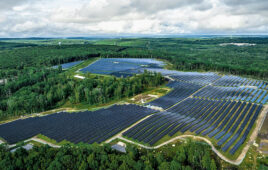
Michael Ludgate, Vice President for Business Development, APS America
Since entering the solar market less than a decade ago, microinverters — which convert the DC current from individual PV modules into usable AC power for home and business — have been enthusiastically embraced by system designers and installers. They’re turning up in larger, more sophisticated solar installations every day, a trend that’s not going to change anytime soon.
The tremendous advantages that today’s microinverter technology offers over traditional “string” units is well documented: optimized yield thanks to individual module output, monitoring and control (no more “shading” effects crippling a whole array); flexibility of system design, and ease of installation; lower costs, including balance of system components; and the increased safety of distributed current.
Perhaps even more exciting is the fact that microinverters have only scratched the surface of their potential, as focused research and development across the industry pushes this technology even farther forward.
New microinverters will support the evolving demands of thin-film/CIGS modules now entering the solar market in residential and commercial installations, promising still higher energy yield per array area. Microinverters’ flexible design accommodates the higher voltages of the new module technology, while rapid shutoff features ensure safety for system installers and emergency responders. As highlighted in the NEC 2014 changes, safety will continue to be a key feature going forward as state electrical codes are modified to keep up with the spread of solar across our communities.
The introduction of microinverter technology offering true 3-phase (277/480) DC power output will further boost microinverters’ value in the marketplace, simplifying and enhancing the use of solar arrays in the largely untapped niche of large-scale commercial developments. This is one more example of the ongoing trend toward product differentiation across the microinverter market; new features and improved performance mean microinverters won’t be mere commodities, indistinct from one maker to the next. The future will belong to the innovators.

We’ll also see continued evolution of module monitoring with cloud-based systems that offer faster response time, improved ease of access to performance data and enable remote array troubleshooting. All of these will improve the user experience while boosting energy output and speeding investment payback. This is where it really counts, at the consumer level.
With so many advantages, it’s evident why solar industry analysts agree that the microinverter market, and module-level power electronics in general, will see strong capital investment, innovation and growth for the foreseeable future.
By Michael Ludgate, Vice President for Business Development, APS America
Want more? Try these articles:
Reports Suggests Microinverters And DC Power Optimizers Will Be Critical To Solar Grid Integration
Installation Notes: Welcome To The Net-Zero Neighborhood
Do We Need Solar Inverter Reliability Standards? Here’s What Manufacturers Think
Adaptive Microinverters Help Solar Adjust To The Future





As far as I know, micro inverters are only good for grid tie systems, if you want to go off grid, like many people in Nevada and Hawaii (now that you will have to pay a fee for using the sun), you will need to spend money on charge controllers, sine wave inverters and micro inverters will have to be discarded. Is there a way to use micro inverters on an off grid system?